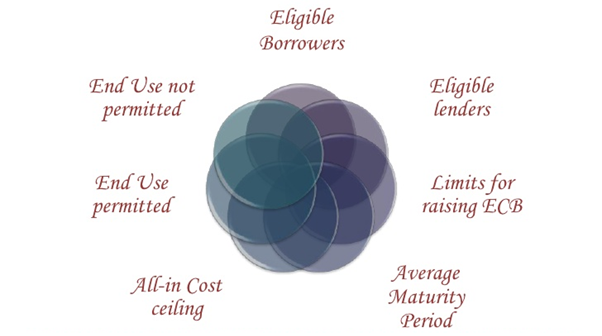What is ECB: External Commercial Borrowings are commercial loans raised by eligible resident entities from recognised non-resident.
The ECB has been classified in category
- Foreign Denomination ECB: Loan raised in any freely convertible Foreign Currency
- INR Denomination ECB: Loan raised in INR
Method of raising ECB: ECB can be accessed under two routes, viz.
- Automatic Route
- Approval Route
Automatic Route: For the automatic route, prospective borrowers need not to take RBI approval for raising ECB, in this the cases are examined by the Authorised Dealer Category-I (AD Category-I) banks.
Approval Route: In this the prospective borrowers are required to send their requests to the Reserve Bank through their AD Banks for examination.
Aspect to be focused under Automatic route are as under:

| Parameters | FCY denominated ECB | INR denominated ECB | ||||||||||||||||||
| Forms of ECB | i. Bank Loan
ii. Security Instrument (e.g. floating/ fixed rate notes/ bonds, Non- convertible , Optionally Convertible or Partially convertible Preference share/Debenture iii. Trade credits (Buyers Credit, Suppliers Credit) iv. FCCBs (Foreign Currency Convertible Bonds) v. FCEBs (Foreign Currency Exchangeable Bonds) vi. Financial Lease. |
i. Bank Loan
ii. Security Instrument (e.g. floating/ fixed rate notes/ bonds, Non- convertible , Optionally Convertible or Partially convertible Preference share/Debenture iii. Trade credits (Buyers Credit, Suppliers Credit) iv. Financial Lease. v. Plain vanilla INR denominated bonds issued overseas, which can be either placed privately or listed on exchanges as per host country regulations. |
||||||||||||||||||
| Eligible borrowers | All entities eligible to receive FDI. Further, the following entities are also eligible to raise ECB:
i. Port Trusts; ii. Units in SEZ; iii. SIDBI; and iv. EXIM Bank of India. |
i. All entities eligible to raise FCY ECB; and
ii. Registered entities engaged in micro-finance activities, viz., registered Not for Profit companies, registered societies/trusts/ cooperatives and Non-Government Organisations. |
||||||||||||||||||
| Eligible lenders | i. The lender should be resident of Financial Action Task Force (FATF) or International Organisation of Securities Commission’s (IOSCO) compliant country, including on transfer of ECB.
ii. Multilateral and Regional Financial Institutions where India is a member country iii. Individuals as lenders can only be permitted if they are foreign equity holders* or for subscription to bonds/debentures listed abroad iv. Foreign branches / subsidiaries of Indian banks are permitted as recognised lenders only for FCY ECB (except FCCBs and FCEBs) v. Foreign branches / subsidiaries of Indian banks, subject to applicable prudential norms, can participate as arrangers/underwriters/market-makers/traders for INR denominated Bonds issued overseas. vi. Underwriting by foreign branches/subsidiaries of Indian banks for issuances by Indian banks will not be allowed. *Foreign Equity Holder: It means (a) direct foreign equity holder with minimum 25% direct equity holding in the borrowing entity, (b) indirect equity holder with minimum indirect equity holding of 51%, or (c) group company with common overseas parent |
|||||||||||||||||||
| Limit for raising ECB | i. All eligible borrowers can raise ECB up to USD 750 million or equivalent per financial year
ii. Further, in case of FCY denominated ECB raised from direct foreign equity holder, ECB liability-equity ratio for ECB raised cannot exceed 7:1* iii. This ratio will not be applicable if the outstanding amount of all ECB, including the proposed one, is up to USD 5 million or its equivalent. E.g. Direct or Indirect Equity holding by foreign equity holder is USD 100 million then the prospective borrower can raise ECB up to USD 700 million subject to maximum ECB limit of USD 750 million per financial year * This ratio will not be applicable if the outstanding amount of all ECB, including the proposed one, is up to USD 5 million or its equivalent. |
|||||||||||||||||||
| Minimum Average Maturity Period (MAMP) |
|
|||||||||||||||||||
| All-in-cost | Benchmark rate* + 450 bps spread.
Benchmark rate: Benchmark rate in case of FCY ECB refers to 6-months LIBOR rate of different currencies or any other 6-month interbank interest rate applicable to the currency of borrowing e.g. EURIBOR. Benchmark rate in case of Rupee denominated ECB will be prevailing yield of the Government of India securities of corresponding maturity. Note : Prepayment charge/ Penal interest, if any, for default or breach of covenants, should not be more than 2% over and above the contracted rate of interest on the outstanding principal amount and will be outside the all-in-cost ceiling. |
|||||||||||||||||||
| End-uses (Negative list) | The negative list, for which the ECB proceeds cannot be utilised, would include the following:
i. Real estate activities. ii. Investment in capital market. iii. Equity investment. iv. Working capital purposes, except as allowed in MAMP above. v. General corporate purposes, except as allowed in MAMP above vi. Repayment of Rupee loans, except as allowed in MAMP above vii. On-lending to entities for the above activities, except as allowed in MAMP above |
|||||||||||||||||||
Other points to be take care
Borrowers may enter into loan agreement complying with ECB guidelines with recognised lender for raising ECB under Automatic Route without prior approval of RBI. The borrower must obtain a Loan Registration Number (LRN) from the Reserve Bank of India before drawing down the ECB.
Loan Registration Number (LRN): To obtain the LRN, borrowers are required to submit duly certified Form ECB, which also contains terms and conditions of the ECB, in duplicate to the designated AD Category I bank.
In turn, the AD Category I bank will forward one copy to the Director, Reserve Bank of India, Department of Statistics and Information Management, External Commercial Borrowings Division.
Note: Copies of loan agreement for raising ECB are not required to be submitted to the Reserve Bank.
Monthly Reporting of actual transactions: The borrowers are required to report actual ECB transactions through Form ECB 2 Return through the AD Category I bank on monthly basis so as to reach DSIM within seven working days from the close of month to which it relates. Changes, if any, in ECB parameters should also be incorporated in Form ECB 2 Return.
Late Submission Fee (LSF) for delay in reporting:
| Type of Return/Form | Period of delay | Applicable LSF |
| Form ECB 2 | Up to 30 calendar days from due date of submission | INR 5,000 |
| Form ECB 2/Form ECB | Up to three years from due date of submission/date of drawdown | INR 50,000 per year |
| Form ECB 2/Form ECB | Beyond three years from due date of submission/date of drawdown | INR 100,000 per year |





